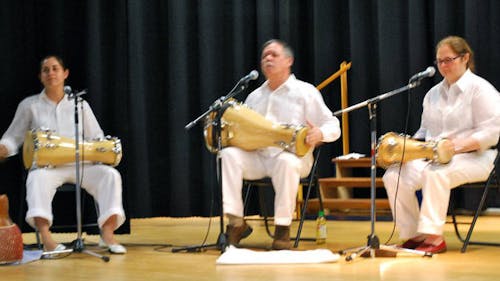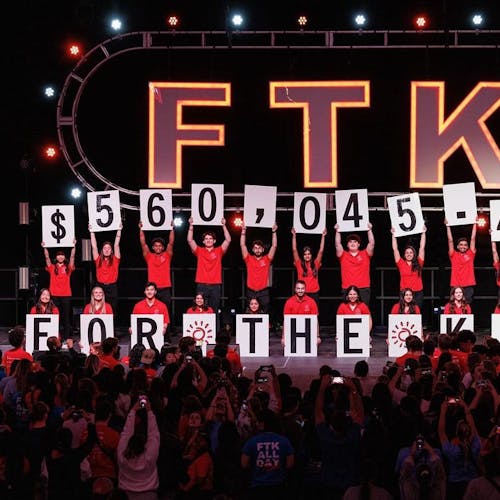Caribbean rhythms connect heartbeats of community members

New Brunswick and the neighboring Highland Park are home to a large and vibrant Caribbean community that brings diversity and culture to the area. As my family is from Trinidad and Tobago, I was pleasantly surprised to hear that one local nonprofit is doing their part to showcase and promote the music and culture from the Caribbean Islands.
Who Is My Neighbor? Inc. (WIMNI), an organization that champions diversity through connecting the local community, hosted “Percussion Rhythms of the Caribbean” last Saturday. The show featured performances from the Black Circle Symphony and Raíces Cultural Center Ensemble, two local music collectives influenced by Afro-Caribbean beats. Lara Arp, the executive director of the nonprofit, created this event to celebrate and share the sounds and rhythms of the Caribbean to connect neighbors in the community.
“We want to celebrate the diversity in New Brunswick and Highland Park (by) creating a sense of belonging for the community and finding local artists,” Arp said.
Upon arriving at the social room of the Reformed Church of Highland park, people of all ages were enjoying the music and experiencing a new culture. Francisco Gomez, co-director of Raíces Cultural Center, said that his ensemble wanted to perform the influence African drums had in shaping the Caribbean culture and subsequently American culture as well.
The Black Circle Symphony took to the stage first, performing songs and rhythms from the Dominican Republic, Trinidad and Tobago and Jamaica. This five-person symphony, lead by Ras Ujima, a Rutgers alumni, and accompanied by Bob Ramos, a professor in the Department of Latin Studies, rapped and beat their drums in perfect unison, encouraging the audience to become the sixth member of the group by clapping along to the infectious beat.
In between songs, Ras Ujima spoke to the audience about origins of the rhythms they were performing. Many of the songs were created in result of the migration of African slaves from the Gold Coast to the Caribbean and the ultimate creolized culture that ties African, Spanish and Taino culture together.
“(These songs we perform have) contributions from European, Indigenous and African culture. The highest amount of creativity, compassion and art (are made) when collaborations are made,” Ramos said after the group performed a spiritual song, sung by slaves as a form of artistic expression and a form resistance against their forced captivity.
Ramos gave me his card, which described his second job as a percussionist and invited his “Music of the Caribbean” class to come and enjoy the event. When he stood up from his seat and began a solo performance, the student section screamed in excitement.
This solo marked the transition into a fast-paced rhythm that resembled the high-intensity sound of bachata or merengue straight from the Dominican Republic. If I was not as uncoordinated as I am, I would have stood up and started dancing, but I settled for moving my hips and nodding my head from the safety of my seat.
Honestly, the beats and the lively environment were so contagious that it was bringing out the Caribbean in me, taking me straight to Carnival in Trinidad and Tobago — I was too close to getting a whistle or tapping my pen to a bottle to join along.
The ensemble also celebrated the 90th birthday of “King of Calypso,” Harry Belafonte. Belafonte is an American singer and social activist who popularized Caribbean musical style to an international audience in the 1950s. They performed his iconic song and my personal favorite, “Banana Boat Song (Day O).”
Most people do not know the song by name, but once the chorus hits, everybody sings along — it’s almost instinctual. As soon as Ujima sang “Day, he say day-ay-ay-o, daylight come and he wan go home,” the audience began singing along to the Jamaican folk song.
Before leaving the stage, Ujima said, in line with the Rastafarian faith, “Peace and love, wake up Caribbean people, wake up. Caribbean music connects us to our past.”
The four-person Raíces Cultural Center Ensemble was up next and went on stage. Before its performance, Gomez, who is of Taino descent, spoke about the history of the conch shell, which was used by the indigenous groups of the Caribbean to emit good vibrations and thoughts to a higher being.
In a salute to the four corners of the earth, Gomez blew the conch and the entire ensemble encouraged the audience to keep First Nations people, African slaves and those protesting at Standing Rock in their thoughts and prayers during the ritual.
The ensemble’s performance focused on Cuban and Puerto Rican rhythms that originate from the Yoruba culture. Using only Yoruban drums, authentically made from ship barrels that were carried on slave ships, the group performed Bamba, which was a drum style created by Puerto Rican slaves that forged a connection between a drummer and a dancer. Gomez took the role as drummer and with every movement Nicole Wines, co-directer of the center, made, he responded with a beat, allowing Wines to control the speed, tempo and beat of the interaction.
Gomez said that rhythms like these were created to foster community because it was a communal performance.
Each song performance directly correlated with the timeline of the Caribbean — from the original African culture, to the arrival of African slaves and the preservation of their culture and finally the creolization and collaboration of many ethnicities to form one, unique culture.
By the end of the event, it was clear to see that each performer and even those in the audience understood and appreciated the countless contributions made by African slaves and indigenous people to form the cross-generational, cross-cultural and beauty that is the Caribbean culture.



